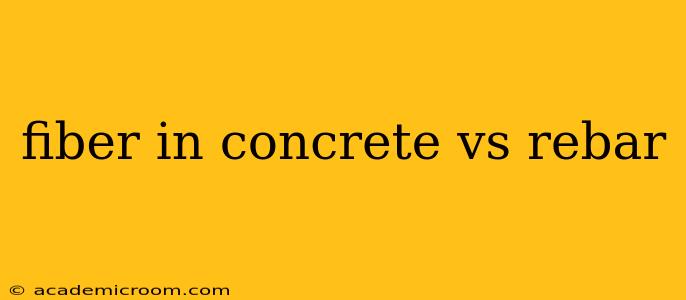Reinforced concrete, a ubiquitous material in construction, relies on steel rebar to provide tensile strength. However, fiber-reinforced concrete (FRC) offers a compelling alternative, using fibers dispersed throughout the concrete matrix to enhance its properties. Understanding the differences between these reinforcement methods is crucial for selecting the appropriate material for a given application. This article will delve into the key distinctions between fiber in concrete and rebar, exploring their strengths, weaknesses, and ideal use cases.
What is Rebar?
Rebar, short for reinforcing bar, consists of steel rods or bars embedded within concrete structures. These bars provide tensile strength, a property concrete lacks, preventing cracking and improving overall structural integrity. Rebar is typically placed in a grid-like pattern, strategically positioned to withstand anticipated stresses. The size and spacing of rebar are determined by engineering calculations based on the structure's intended load-bearing capacity.
Advantages of Rebar:
- High Tensile Strength: Rebar provides significant tensile strength, enabling concrete to withstand substantial pulling forces.
- Established Technology: The use of rebar in concrete construction is a well-established and understood practice, with extensive design codes and guidelines.
- Predictable Behavior: The mechanical behavior of rebar is well-characterized, allowing for accurate predictions of structural performance.
Disadvantages of Rebar:
- Corrosion Susceptibility: Rebar is susceptible to corrosion, particularly in environments with high moisture content or chloride exposure. This can significantly compromise the structural integrity of the concrete over time.
- Labor Intensive Installation: Proper placement of rebar requires skilled labor and careful planning, increasing construction costs and time.
- Cracking Potential: While rebar helps mitigate cracking, it doesn't entirely prevent it. Cracking can still occur, potentially leading to reduced durability and aesthetic issues.
What is Fiber in Concrete?
Fiber-reinforced concrete (FRC) incorporates short, discrete fibers dispersed throughout the concrete mix. These fibers can be made from various materials, including steel, polypropylene, glass, and carbon. The fibers act as a distributed reinforcement, enhancing the concrete's tensile strength, flexural strength, and impact resistance.
Advantages of Fiber in Concrete:
- Improved Crack Control: FRC exhibits superior crack control compared to plain concrete, leading to increased durability and reduced maintenance.
- Enhanced Impact Resistance: The presence of fibers improves the concrete's ability to withstand impact loads, making it suitable for applications subject to shocks or vibrations.
- Reduced Shrinkage and Cracking: Certain types of fibers can reduce the shrinkage and cracking that occur during the curing process.
- Easier and Faster Placement: The absence of individual rebar placement significantly reduces labor costs and construction time.
Disadvantages of Fiber in Concrete:
- Lower Tensile Strength (Compared to Rebar): While FRC improves tensile strength, it generally doesn't match the high tensile strength provided by rebar in heavily loaded structures.
- Material Cost: Depending on the fiber type, the cost of FRC can sometimes exceed that of plain concrete, although labor savings can offset this.
- Limited Applicability in Large Structures: FRC is not typically suitable for large-scale structural applications requiring the high tensile strength provided by rebar.
Fiber in Concrete vs. Rebar: Which is Right for Your Project?
The choice between fiber in concrete and rebar depends heavily on the specific application and project requirements.
When to Use Rebar:
- High-load-bearing structures: Bridges, high-rise buildings, and other structures subjected to significant loads typically require the high tensile strength provided by rebar.
- Structures requiring precise reinforcement: Situations where precise reinforcement placement is critical for structural integrity benefit from the control afforded by rebar.
When to Use Fiber in Concrete:
- Applications requiring enhanced impact resistance: Pavements, sidewalks, and other areas subjected to impact loads are ideal candidates for FRC.
- Projects prioritizing crack control and durability: FRC is suitable for applications where reducing cracking and improving long-term durability are paramount.
- Situations where ease of placement is important: Projects requiring faster construction and reduced labor costs may benefit from the ease of placement of FRC.
What are the different types of fibers used in concrete?
Several types of fibers are used in fiber-reinforced concrete, each with its own properties and applications. These include steel fibers, polypropylene fibers, glass fibers, and carbon fibers, each offering unique advantages and disadvantages depending on the specific needs of the project. The selection of the fiber type depends on factors like required strength, durability, cost, and the expected environmental conditions.
How does fiber-reinforced concrete compare to traditional concrete in terms of strength and durability?
Fiber-reinforced concrete significantly improves the strength and durability of traditional concrete. It enhances tensile strength, flexural strength, and impact resistance. This increased strength and durability lead to improved crack control, reduced shrinkage, and increased longevity. The overall result is a more resilient and long-lasting concrete structure.
What are the environmental considerations for using fiber-reinforced concrete?
The environmental impact of FRC depends on the type of fiber used. Steel fibers have a higher embodied carbon footprint compared to synthetic fibers like polypropylene. However, the improved durability of FRC can lead to a reduced lifecycle environmental impact due to less frequent repairs and replacements. Life cycle assessments should be conducted to determine the overall environmental performance of FRC compared to traditional concrete for a given application.
In conclusion, both rebar and fiber in concrete offer valuable contributions to the construction industry. The optimal choice hinges on a thorough understanding of project requirements, balancing factors like cost, performance, and long-term durability. Careful consideration of the specific application will guide the selection between these effective reinforcement methods.
